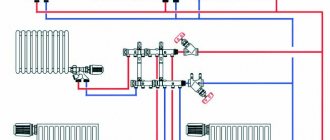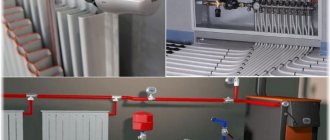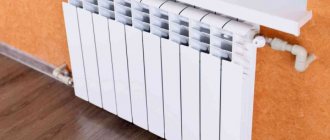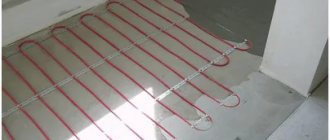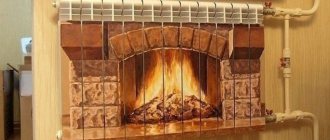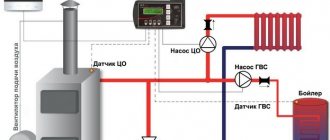Options for closing heating pipes
You can use decorative pipe covers. This will help reduce the cost of heating system equipment. Sometimes this is a fairly economical option.
Functions of decorative overlays:
- Hiding batteries and pipes completely or partially;
- Protective function against hot radiators;
- Fitting the box into the design of the room;
- Simplifies maintenance as dust does not accumulate on the battery;
- Some pad options help distribute heat evenly.
The pipes can be covered with a wooden frame, having previously painted it.
But when choosing decoration, it is important to take into account not only beauty, but also practicality. It is necessary that the material does not reduce heat transfer and does not emit toxic substances during heating
Plastic, for example, must withstand high temperatures for a long time. It is also important that the material does not change color or shape during use.
Decoration should not stand in the way of heat transfer from the radiator.
The decorative box must meet a number of parameters when used. The overlay should not take up much space; you should choose the most compact options. The fastening of the structure must be strong enough, but at the same time it is necessary to provide for the possibility of access to the batteries
It is also important that the box is not too heavy
How to hide heating pipes in a private house, methods and materials
There are pipelines in every apartment. A modern interior involves decorating the room with taste, so that everything is neat and stylish. Therefore, the question of how to close heating pipes worries many owners. Today there are a number of ways in which you can solve the problem of the unaesthetic appearance of heating structures. The article will discuss the most effective of them. There is a large selection of heating systems on the market. To decide which pipes to use for heating a private house or apartment, you need to consider the physical properties of the product, performance characteristics, installation and application conditions. There are pipes that look aesthetically pleasing and do not spoil the interior of the room, but are of low quality and have low technical parameters. And there are reliable and durable options, but not particularly attractive in appearance. To create a stylish design, such pipes have to be hidden.
Decoration of heating pipes: sockets, screens and other solutions
The climate of our country is such that we simply cannot survive in the long winter without heating. But risers and pipes, and even radiators, do not always serve as interior decoration, and often simply spoil the decor. Most often, this can be said about houses that were built several decades ago: no one thought much about attractiveness, everything was subordinated to rationality. But today there are many ways to solve the problem: from purely decorative to “decorative and construction”.
Decoupage batteries
To decorate a battery using the decoupage technique, you need the following materials:
- drawing for decorating a battery using decoupage technique;
- acrylic paints;
- PVA glue;
- white enamel;
- brushes;
- sandpaper;
- heat-resistant varnish.
In order to decoupage the battery, you need to prepare it. To prepare, you need to clean the battery, go through sandpaper and remove excess old paint and create a smooth, even surface.
After sanding, wash the heating radiator and wait until it dries completely. Only then start painting.
To paint the battery, it is better to use white enamel, but not nitro.
After knocking, when the battery is dry, take a drawing or napkin for the battery decoupage technique and measure the width of the outer surface.
It all depends on the design you choose. We glue our drawing in the center of the edge of the battery.
To glue the drawing, take PVA glue and dilute it with water in a 1:1 ratio, in this state it will fit better on the paper.
Having thus glued the entire drawing, you need to finish painting the part of the battery remaining without a napkin with acrylic paints. If you draw well, you can complement the decoupage of the battery with brushes.
When the decoupage on the battery is dry, coat it with heat-resistant varnish.
You can also decorate the battery with other designs. Usually different colors and patterns are used.
Pipe decor
Pipes, like batteries, can be decorated in an original way. There are several options for decorating pipes with your own hands:
- wrap the pipes with thick threads or ropes;
- knit a pipe cover that will be applied to the pipe;
- paint the pipe in original colors, for example, multi-colored stripes.
The last option, which involves painting, may require different paint colors, but is ideal for a child's room.
How to decorate a pipe using a hook and thread
It is enough to simply knit a long knitted strip, the width of which will correspond to the size of the girth of the pipe. The strip may not be circular, and it is not at all necessary to make a cover out of it.
To decorate the pipe, you will only need loops placed in a certain sequence, but you can make them during the knitting process in accordance with the chosen pattern.
A rope similar to a lace will be threaded through these loops, which will be tied either at the bottom, or at the top, or in several places into a beautiful bow.
Pipe decor with rope
Another option for decorating unattractive pipes is to use beautiful structural rope.
It simply needs to be tightly wrapped around the pipes with vertical stripes. To secure the rope while threading its ends, you must use glue.
Decoupage pipes
You can decorate pipes using the decoupage technique. To do this, you will need either a special film for decoupage, which is sold in a craft store, or ordinary napkins with a suitable pattern.
As a rule, Shabby Chic decoupage involves the use of light, warm and delicate colors. To decorate a pipe, you need to perform the following sequence of actions:
- pre-clean the surface for decorating the pipe;
- apply glue to the pipe;
- cover the surface with a napkin;
- apply glue again so that the entire napkin is soaked through for better adhesion;
- varnish.
You can cut out a design on a napkin if it shows a pattern that specifically suits you. As a background, you can use another napkin with soft colors, which under no circumstances should be cut.
The ideal solution for decorating a pipe using the decoupage technique is to tear it, so the background borders will be smooth.
The decor of pipes can be very different. For example, you can paint a pipe in the shape of a birch tree trunk, and attach sheets of paper cut out to the walls, which will create an original image of a tree, or replace the sheets with artificial ones.
Decorative grille for radiator
The radiator grille is a great decoration and a way of camouflage. The simplest option for creating such a lattice is a structure made of bamboo rods. The rods should be thick, and they should be easy to cut, adjusting the size of the grille to the size of the radiator.
The rods can be secured with wire or glue, but the glue will, of course, be less noticeable.
The radiator can be disguised as a fireplace by making a wooden mesh for it, decorated with different patterns. This fireplace fits perfectly into almost any type of interior if it is placed against the wall.
Like door decor, decor of pipes, radiators and radiators may require painstaking work, imagination and a lot of time, but with the help of decor you can hide what spoils the appearance of your home.
Unusual alternative
The methods for decorating pipes that were described above are standard. Along with them, there are also more original ones, using which you can not only hide, but also aesthetically decorate heating pipes.
Painting
The color is chosen to match the wall or you can play with contrast. A quite interesting solution is a holistic ornament present both on the pipe and on the surface of the wall. The main point when painting is to choose the right paint material. Water-dispersed compositions adhere well to metal. Also, when painting pipes, you can use alkyd enamels and acrylic-based paints. They are highly resistant to elevated temperatures and are non-toxic.
Wrap the pipes with hemp or jute rope. Using such decorative material, you can create an unusual decoration on heating pipes. This method of decoration also has disadvantages. The main thing is to reduce heat transfer from the heating riser.
Place a hollow bamboo trunk
To use this method, you need to cut it lengthwise and then wrap it around the riser, after which they are glued together. As an addition, you can use flowers and leaves to decorate the pipes.
Hide with stained glass or cover with curtain rods and furniture
In the first case, you get a partition with an original ornament.
In the second, it is ideal to use curtain rods that can be installed independently without any problems. Then they can be painted or wallpapered. You can also hide vertical communications using a tall cabinet. And if the task is to make horizontal pipes invisible, then in this case it is necessary to arrange a shelf.
Masking heating pipes
It doesn’t matter whether it’s an apartment or a house, a bedroom or a kitchen, everywhere I would like to have a good renovation. Questions immediately arise: how to beautifully hide heating pipes and how can this be done with minimal cost and maximum efficiency? At the same time, the method of disguise should be truly invisible and unnoticeable, fitting into the room
The pipe can be hidden inside the wall, or it can also be closed into the floor. Remember that the old heating system should not be hidden in this way; this option is possible after a complete update of all elements.
Box on frame
It is best made from wood, plastic or plasterboard. Do not place the heating pipes close together; there should be at least three centimeters between the box and the pipe.
Hide behind decor
Decoration of pipes in various ways, for example, wrapping them with jute rope. But remember that this reduces heat transfer. Many owners decorate pipes with flowers; this can be done using bamboo with leaves. Only imagination should work here; even an old pipe can look completely different.
Painting to match the color of the walls
The easiest and most practical method is to paint the radiators or riser in the same color as the walls, but the heat generation will not be reduced.
In the photo in the kitchen interior, the pipes are painted to match the blue walls.
Hide under the floor plinth
A good invention was the floor plinth, in which you can easily hide batteries located horizontally and low to the floor.
How to cover heating radiators with decorative screens?
When a decision is made on how best to hide heating pipes in a modern apartment, the use of screens is the fastest and most effective. Old-style heating batteries function no worse than new ones, and sometimes it makes no sense to change them. Screening them does not require the help of professionals. It is best to cover risers and radiators with screens when they are located at a distance from the wall. It should be taken into account that up to 15% of the heat will be lost.
Decorative overlays and a plastic box for heating pipes are often transformed into a cabinet or cabinet. Materials are purchased in stores or decor is made from improvised materials.
Apartment owners are interested in the question: is it possible to leave the valves accessible in the presence of a screen in order to repair radiators, regulate the temperature and bleed air when it gets into the heating system? To do this, the screen is made removable or the ends of the batteries are left open. Also, the surface of the screen is made with holes or slits in order to improve heat transfer and reduce energy loss.
If the heating radiators protrude outward, they are covered with a box. Panels are used for radiators in niches. Materials can be metal, plastic, wood, glass, etc. Products must match the interior of the premises in color, design or pattern.
USEFUL INFORMATION: Mixer combined with drinking water filter
It is advisable to choose glass screens for heating radiators that do not transmit radiation and do not reduce convective heat transfer, if the gaps are chosen correctly. They are easy to remove and clean. Tempered glass does not break, but many now prefer a screen made of transparent acrylic due to its light weight, variety of shapes and colors.
Which decorative screen is better
At the moment, decorative boxes for pipes of heating systems are made from the following materials:
- plastic;
- metal;
- MDF;
- wood.
Plastic is one of the worst materials for making boxes designed to hide hot pipes. The fact is that in order to reduce prices, manufacturers use inexpensive types of plastic for these products. Such material quickly warps from heating, loses its appearance, or even turns yellow and becomes brittle. Of all types of screens, a plastic pipe box is the cheapest, but it does not last long and is well suited as a temporary solution to the problem. The plastic box made to look like a plinth deserves attention, but this is a different price category.
Metal, on the contrary, is the best solution for decorative fencing of heating risers and mains. Products with frequent perforations or lattice designs are especially good. Metal is an excellent conductor of heat and will successfully transfer it into the room, and through the holes the casing will allow enough air inside for heating. So from the technical side, metal has no equal.
From the point of view of operation, steel products are also at their best. They are coated with a durable polyester powder coating that can withstand high temperatures and various mechanical stress. Again, metal boxes can always be repainted if necessary, so they will last a long time. Well, the last argument in favor of steel screens: they are easy to clean in any way, even wipe with a rag, or remove and wash in the bathroom under running water.
Tube decor in the kitchen and bathroom
If you need to hide and decorate communications in the kitchen, then this can be easily done with the help of a furniture set. This way, horizontal risers can be easily hidden behind a kitchen cabinet.
A vertical pipe can easily be veiled with a floor pencil case. With a small budget, you can safely use furniture that imitates the real thing. False structures will help you easily hide unsightly communications that do not fit into the overall design of the room.
You can disguise a gas pipe using parts of a furniture set. This method is the most optimal. You will not only hide the pipes, but also, if necessary, you will have free access to the column, fittings and meter.
You can also decorate any heating pipe in the bathroom quickly and easily. This can be done using the methods described above or any others. Before starting work, it is recommended to clarify information about what material the pipe is made of: stainless metal, plastic, etc. Most modern materials do not need painting. If the pipe is made of ferrous metal, then it must be cleaned of old material before painting.
There are many ways to decorate a pipe. After weighing all the pros and cons, you can find the best option for yourself.
When choosing it, it is important that the overall stylistic idea in the room is maintained.
Any unsightly pipe can be turned into an original decorative element in the room. When decorating, do not forget that the heating or gas pipe must, first of all, fulfill its main functional task. If you are creative, the result will exceed all your expectations.
How to decorate pipes with your own hands?
The easiest way is to paint the pipes to match the wall
See also: How to connect a gas stove in an apartment yourself.
Dye
The correct selection of decor colors can easily revive even the most unsightly thing; set the mood for a living room, bedroom or nursery. By the way, if communications run through the children's room, you simply need to involve your child in the creative process: it will be interesting for him, and it will be handy for you. If you have drawing skills, then the batteries can be easily painted to look like different animals. For example: a boa constrictor or a giraffe. All sorts of decoration attributes will add greater originality.
Giraffe pipe or birch tree pipe - suitable decor for a children's room
See also: DIY New Year's wreath, step-by-step instructions.
Hide under twine
The freshly painted heating system must be braided in a circle with a rigid rope (colored cord), thus simulating a tree trunk (palm tree). Artificial leaves, real tree branches, and wooden rings will help complete the picture. Also, you can bring in original decorative elements that are already present in other rooms, thereby highlighting the commonality of style.
Lemon tree from a heating pipe
By the way, this option may affect the thermal conductivity of heating pipes, but if this is not important to you, then go ahead!
See alsoHow to use shelves in the interior, photo.
Imitation shelf
Perfectly implemented on a horizontal heating system. Use hemp cables, twine ropes - you can attach a neat decorative shelf to them for storing trinkets and other light things. If the room is still under renovation, the shelf can be made more solid. Then it will be able to fully function and still be useful for everyday use.
Decorative shelves suspended on a horizontal pipe
See alsoHow to decorate a battery: recommendations from designers and heating engineers
Hide in a box
An original solution that will suit adherents of minimalism and geometric shapes. You can build a box without much difficulty: you only need a sheet of metal, fiberboard; at worst, ordinary plywood (plasterboard) will do. But the result is a neat appearance of the wall without unnecessary clutter of heating pipes, as well as other heating communications.
A simple box made of planks with a small shelf
Stylish box made of sheet material and wooden slats, painted to match the brick wall
Masking a pipe using a galvanized profile
See alsoHow to decorate a tabletop: decoration methods, materials and ideas from designers
Hide in a locker
Convenient, simple, concise. Installing this element is not difficult, especially if you are not the one doing the repairs. You can ask a specialist - he will offer the most optimal options, and at the same time tell you how to fit the wardrobe into the interior. In addition, the secret locker is very convenient. Especially when suddenly you urgently need access to the battery (for example, adjust the pressure, fix a leak).
Cool cabinet in the bathroom
See alsoKitchens with a gas boiler: design
How to hide wires
Surely, before starting renovations, many people think about how to hide the wires in an apartment or private house so that they do not spoil the interior.
The advantage of the renovation is that before finishing work you can plan the required number of sockets and switches, so that you don’t have to install additional ones later when all the work is completed. In addition, you can draw up a diagram of the electrical wiring embedded in the walls, so that later you do not accidentally break one or another wire.
First of all, think about how many outlets you will need and for what appliances. Then you need to groove the wall for the wires. All wires are located either horizontally or vertically. Diagonal placement is not allowed. The distance from the ceiling and floor is maintained at approximately 15-30 cm. In addition, all wires are removed from corners, windows and doors.
How to hide wires? There are two ways to hide wires - open and closed. So, open involves the use of corrugations, pipes and ducts, installation behind skirting boards and decorative panels. Sometimes it happens that this is the only installation method. For example, in a house made of timber, where it is simply unrealistic to cut logs. The open method of hiding wires has its advantages - you can quickly get to the place in case of damage.
A closed way to hide the wires is by cutting the wall and installing it under the plaster. After all the finishing work is completed, only the end points are visible on the wall - the sockets. The advantages of this method are obvious - the wires are not visible, they do not interfere or spoil the interior. But even in the event of a break, it is difficult to get to such a wire - you will have to re-drill the wall.
Sometimes you have to combine an open method of wiring with a closed one. For example, power cables can be hidden in the wall, and low-current cables - telephone, Internet, TV - in boxes. There is an explanation for this method: the electromagnetic field created by the power cable interferes with the operation of low-power wiring.
The most common way to hide communications today is to lay them in the walls, in gypsum fiber board boxes, in a floor screed or under a suspended ceiling. The disadvantage of this installation is the inaccessibility of wires and pipes in the event of a breakdown or leak - you will have to completely open the walls, remove the screed and suspended ceilings.
If there is no way to hide communications, then you can go the other way - disguise or decorate them. For example, you can use ribbons, lace, even ropes to decorate pipes. Or you can simply cover them with the same wallpaper that covers the walls.
Sealing pipes using a special box
This method can be successfully used when repairing existing communications. The first thing you need to do is decide on the material of the box. The box is usually made from the following materials:
- drywall;
- wood;
- special profile;
- plastic;
- metal
Installation of plasterboard box for heating pipes and wooden box
The cheapest way is to cover the heating pipes with plasterboard. This material is easy to process, and with its help you can make a frame of almost any shape. Having installed such a box, all that remains is to finish it. All modern finishing materials for interior decoration are suitable for this - wallpaper, tiles, lining, stucco, etc.
Such a box can become a decoration for any room; with its help it is easy to create a unique design. It is suitable not only for hiding pipes, but also for creating niches for batteries (radiators). To service pipes and batteries, special hatches can be provided in such a box, allowing them to be serviced during repairs.
When making a frame from plasterboard, the following operations are carried out:
- using a pencil, ruler, level and plumb line, mark the contours of the proposed frame;
- a guide metal profile is installed along the drawn lines; it is secured with dowels or shock-absorbing tape;
- then the rack elements are inserted into the profile; The profiles are fastened to each other using metal screws;
- the frame thus obtained is sheathed with plasterboard; to attach it to the frame, screws are used, the heads of which are inserted into the body of the drywall no deeper than 1 mm;
- seal the attachment points and seams with putty;
- external and internal corners are reinforced with a corner metal profile;
- prime the finished structure and, if necessary, putty;
- Next, the finishing of the box is carried out.
Making a plasterboard box to cover heating pipes
The box can also be made of wood. This will help solve the question of how to hide the pipes if drywall is not available at a particular moment, but decent wooden boards are available. The use of wood to decorate the box will be especially important if the room itself is decorated with wood. This will help maintain its original appearance.
To seal pipes, you can also use other wood-based materials, such as MDF, chipboard, especially with a laminate coating.
Installation of a plastic box for heating pipes
Plastic boxes for heating pipes are also very relevant, especially when it comes to how to seal a heating pipe in the bathroom, hallway, kitchen and other utility rooms.
The procedure for making a plastic box is as follows:
- we mark the frame of the future box; We use a pencil, level, ruler;
- We assemble the frame of the box from metal profiles (similar to the frame for sheathing with plasterboard);
- cut out plastic parts with a hacksaw;
- Using self-tapping screws, special staples or ordinary small nails, we fasten the prepared parts to the frame;
- We cover the joints of plastic elements and their contact with the walls with special decorative corners, starting and finishing elements, as when installing plastic lining.
You can also use metal boxes. They are made of stainless or chrome steel. These are very durable boxes
In addition, metal gives off heat well, which is important for heating rooms. Such metal boxes are most often made when decorating a room in a high-tech style
Using a plasterboard box
The technology for decorating pipes in this way is quite simple. It all starts with the installation of a frame made of profiles. They are attached to the wall using self-tapping screws. Next, the plasterboard walls are fixed. In addition to decorating pipes in rooms, heating risers in the kitchen and bathroom are decorated using this method. However, to decorate using this method, it is necessary to purchase not ordinary, but moisture-resistant drywall. Although the method is distinguished by its simplicity, and the costs of using it are small, it nevertheless has its drawbacks:
- no access to highway;
- prohibition on its use in close proximity to radiators.
Examples of heating pipe decoration
Photos in the interior of the rooms
Kitchen
The kitchen is the ideal room in which all ways to hide batteries will become practical and convenient. If the room is small, then you can hide the radiator with the help of a beautiful tabletop or make a folding table, which will fold out when convenient.
Factories of metal-plastic structures offer a large selection of beautiful large-sized window sills that imitate stone, wood and other materials. A modern window sill does not break under weight, is not afraid of external factors, is easy to care for, wipe clean, is not afraid of scratches, and so on. You can hide any type of battery in this way, including cast iron.
In the photo, wooden boxes are used to disguise the radiators.
Living room
If the radiator is in a niche, then a wide window sill will help create a work area.
You can place souvenirs, vases or potted flowers on the constructed wooden box. You can also cover unsightly radiators in the living room with thick curtains.
The photo shows a modern living room. In order to hide the radiators, a wooden structure was installed, which also serves as a place for rest, storage and decoration.
Bedroom and children's room
In the interior of a bedroom and children's room, batteries can be used as another place to relax, a tabletop for decorative elements or a workplace.
Bathroom
You can hide the pipes in the bathroom using a louvered door, plastic grilles or a cabinet with opening doors.
We hide heating radiators using wooden, glass or plastic screens.
In the photo, the radiators in the bathroom are hidden using a wooden box.
Hallway
For radiators in hallways, glass screens or wooden boxes are suitable. In a small room, covering the battery is only necessary from a practicality point of view. This could be a locker for storing shoes, or the battery will become a small coffee table where keys and other necessary items will be stored.
What is the best way to hide pipes in the bathroom and toilet?
In a standard bathroom and toilet, every square centimeter is important, but at the same time, you want to make these rooms cozy. To achieve this, even in the smallest rooms you need to hide the pipeline and other communications.
Decorating pipes in the toilet and bathroom can be done in several ways. The cheapest option is to simply paint them. But this does not always look beautiful, so more complex techniques are used. It is better to cover unsightly sewer pipes with drywall, tiles, or hide them in the wall. Pipes that remain visible can be replaced with beautiful ones made of copper, plastic or stainless steel. A shiny steel heated towel rail with a round corner and a modern mixer will fit into any bathroom.
Pipe decor
Masking pipes in the kitchen interior
Pipe decor in the toilet
Tile pipe decor
Industrial style pipe decor
Pipe decor with silver paint
Using a plasterboard box is the right interior solution
It is better to hide unsightly pipes behind the toilet or in the bathroom behind a plasterboard box. You make a kind of cover where all the plumbing debris is hidden. This box is installed vertically from floor to ceiling and fits well into the interior.
Construction of a false wall in the bathroom
If the size of the room allows, the pipes can be hidden in a false wall. To do this, they are covered with lathing, and insulation is laid between it and the main wall. After this, a wall is erected from plasterboard, natural wood, MDF or other modern material.
Then the false wall is painted, covered with wallpaper or decorated in another way. There must be access to the disguised water supply and fitting, otherwise in the event of an emergency the artificial wall will have to be broken. You should not cover it with tiles or hang too heavy cabinets on it - it may not withstand their weight. Access should be to the pipes and to the places where the plug is installed.
Pipe decor in the bathroom
Decor and design of pipes
Pipe decor with fabric
Decorative pipes in the bathroom interior
Closing the pipes using stained glass
Pipes in the bathroom and toilet are sometimes covered with mosaics or stained glass. To do this, install a metal or wooden box to which colored tiles made of thin glass or plastic are attached.
You can combine a false wall with a stained glass window. To do this, you need to leave a window in it, into which you insert colored glass. It looks original, and there is always access to communications. To create a cozy atmosphere behind the mosaic glass, you can add lighting.
Tiling pipes in the toilet
Excess pipes can always be hidden behind tiles. To do this, guides are first installed, which are laid with tiles. It turns out to be a column from floor to ceiling. But in order for it to look organic and not stand out from the interior, it needs to be covered with the same tiles as all the other walls. Or you can do the opposite and highlight it with tiles of a contrasting color. The top of such a column is decorated with an order or other decorative elements.
Cabinet for vertical pipes in the bathroom
To make the most efficient use of space in the bathroom or toilet, instead of a plasterboard box, you can order a cabinet for vertical pipes. It is a shelving unit hidden from everyone by wooden or plastic doors. Pipes, a coil, and all other communications are hidden inside it, and additional shelves are installed horizontally.
Such a cabinet can be the entire wall or very small. It fits even into a small room and, most importantly, can be used as a small home warehouse. This is where you can put powder, cleaning products and other things that don't have a place.
Upholstered chair
Photo wallpaper nature
Pipe decor in loft style
Gas pipe decor
Option for hiding heating pipes in the wall
Pipes located along the wall can ruin not only the appearance of the wall, but also the interior design of the entire room. But first of all, we would like to inform you that it is strictly prohibited to completely close the heating pipes in the apartment by hiding them in the wall or under the floor.
- Firstly, there is a law prohibiting, without the consent of the housing office, carrying out “reconstruction of residential premises that involves the installation, replacement or transfer of utility networks...”, and obtaining permission there is not so easy.
- Secondly, this case can be risky in multi-apartment residential buildings, since if a completely walled up riser breaks, you can pretty much flood your neighbors, because not all plumbers are experienced, and some can cheat, as a result of which all the trouble will eventually fall on you .
- And thirdly, if the central heating system is pretty worn out and leaves much to be desired, then even more so, the method of hiding heating pipes in the wall of a room can lead to a decrease in heat transfer in the apartment and the formation of dampness and mold in the apartment.
The option of disguising heating pipes in the wall or under the floor is perfect in a private home, since in such houses an individual boiler is usually installed, where the temperature regime is regulated by the owners and in the event of an emergency, you can easily stop the boiler system and drain the water.
How to close heating pipes in an apartment photo on the wall
First of all, if the heating system in a private house has already been installed, you should carefully inspect the pipes and the system as a whole. It is strictly not recommended to hide metal pipes, especially old ones; it would be better if you replace them with plastic ones. For those who are just building a house and installing a wiring system in a room from scratch, it is much easier for them.
Before starting work, you should draw up a diagram of the future location of the pipe system. Next, in the wall or on the floor, recesses are made with strobes of the appropriate size, using a grinder with a diamond wheel to cut the markings and a hammer drill to deepen the recess itself; if you do not have the proper power tools at hand, you can use the old-fashioned method, that is, a chisel and a hammer.
After the recess in the wall or floor is prepared, all that remains is to drown the pipes
This process is quite simple, but remember, do it wisely, that is, pay special attention to the connection points of fittings, elbows and tees. After laying and installing the pipes, you need to check the reliability of their fastening and the absence of leaks, in order to avoid further troubles
To check the heating system of pipes in a room, follow these instructions, connect the heating system to the pump, then fill it with water and create a pressure that exceeds the working pressure, and then visually inspect all pipe connections for leaks.
In order to reduce heat loss in the system, it is recommended to insulate the pipes with polystyrene foam insulation. To do this, you need to make a side slit in the covers and put it on the pipes; the seams can be taped with special tape. After all the work done, the wall should be given a uniform appearance by covering the openings with mortar and removing all accumulated construction debris.
How to disguise a heating pipe in a room under a screed photo
At the end of the process of completing all the work, a pipe route diagram is drawn up, so that during further repair and construction work, the integrity of the hidden structure will not be accidentally damaged.
Procedure for laying pipes
First of all, it is necessary to develop a laying diagram indicating the exact location of the pipes. This requirement must be met so that during further work, hidden communications are not damaged.
USEFUL INFORMATION: Reverse osmosis, what it is: pros and cons, busting myths
The installation of heating elements is carried out sequentially.
- In walls made of traditional materials, grooves are punched with a size that takes into account the diameter of the pipes, the thickness of the thermal insulation and plaster. The channel is made only vertically, so as not to weaken the supporting structures. Floor slabs cannot be tapped. First, pipes are laid on them, and then they are filled with concrete screed. If it was made earlier, it can be grooved, since the layer is not load-bearing. Under a wooden floor, heating pipes can be laid over the ceiling along the board, which can be removed if necessary.
- The pipes are secured to the wall or floor channel using clamps and dowels.
- The grooves are closed with cement mortar only after testing the system under excessive pressure and temperature for several days.
- Afterwards, the wall should be puttied for finishing so that it becomes smooth and uniform.
How to hide heating pipes in an apartment using a box
The box is considered a good option when the heating system is already installed. The casing can be sheathed with plastic, plasterboard, or wood. Before work, you should ensure the integrity of communications.
Required tools for installation:
- Metal profile;
- Self-tapping screws with dowels;
- Material for the box;
- Screwdriver;
- Drill;
- Scissors for metal.
The box in the apartment can be made of any shape that suits the style of the room.
First, you need to make the frame of the box. The manufacturing material is secured using self-tapping screws. First, the location of communications is marked. The dimensions of the pipes, the thickness of the material and the interval between the walls of the box and the communications are taken into account.
Pipes cannot be installed close to the duct. It is optimal to leave a distance of 3 cm.
Next, building profiles are installed. Then the guides are secured. To fasten the profiles together, cutters are used.
Then the corner profiles are installed. If the interval between the posts exceeds 25 cm, then additional jumpers should be made. If the height of the racks is more than 150 cm, then install horizontal jumpers. When the frame is ready, its design begins. The plasterboard is chamfered before installation. But if tiling is planned in the future, then this process can be omitted.
They begin installing the walls of the box from the side parts and move towards the central ones. After installing the walls, the box must be decorated decoratively. To do this, use tiles, wallpaper, paint.
If you want to hide the batteries, you can build a false wall. The execution technology is similar to the box. First, the frame is made, then the walls are sheathed. A significant disadvantage of this method of decoration is the reduction in room area. If you don’t want to bother with installing these elements, you can purchase a ready-made box at a hardware store.
Interesting design solutions for pipe decoration
If you decide to decorate the pipes yourself, you will first need to familiarize yourself with a wide range of design solutions. Dyeing is the most popular method. You can not only paint a plumbing element in the desired color, but also draw absolutely any design on it. Tree branches will look very impressive. This decor is suitable for anyone. Art education is not required.
Depending on the style of the room, the decor of a gas or heating pipe painted in bronze, gold or silver looks impressive
When choosing a color, pay attention to the color of the wallpaper, doors, window sills
If you are looking for the least expensive way, then try using jewelry for decoration purposes. You can decorate pipes using a wide variety of decorative elements. Materials such as ribbons, buttons, fringe, laces, fabric, fur, beads and much more are excellent for this purpose.
Try to decorate the pipe using a variety of toys in the form of animals, insects, made yourself or purchased at the store. The pipe itself can be painted to match the color of the tree trunk.
The heating pipe can be decorated using stained glass. At first glance, this method may seem incredible. Glass or transparent plastic is used for decoration. This method of decoration can be safely combined with a variety of lighting techniques. In addition, such a spectacular composition can serve as a night light indoors.
